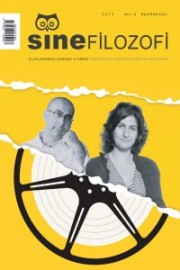Sırta Bakış / Sırtın Bakışı: Sinemada Estetik Modernizm Bağlamında Sırt Takip Plan
Gaze in Back / Gazing Back: Tracking Shot From the Back Within Cinematic Aesthetic Modernism
Author(s): Tülay ÇelikSubject(s): Aesthetics, Recent History (1900 till today), Film / Cinema / Cinematography
Published by: Serdar Öztürk
Keywords: aesthetic modernism; tracking shot from the back; gaze in cinema; modern cinema;
Summary/Abstract: This article aims to analyze, in an aesthetic context, the relationship between modernist tropes and the usage of the tracking shot from the back as a cinematographic form. According to Michel Foucault, the aesthetics of modernism first emerge in forms carried to the foreground. Foucault’s analysis of the paintings of Édouard Manet and René Magritte reveal how themes of expressionlessness-uncertainty, surface-flatness and displacement, all linked to the alterations in the characteristics of the gaze and gaze relations, break down the traditional in representation. These themes, which can be defined as indicative of the qualities of aesthetic modernism, also offer a possibility to demonstrate the distinction between classical and modern cinema. Classical cinema establishes the impression of reality by using cinematic techniques functionally and is thereby linked to forms of mimetic representation that emerged in the Renaissance period. On the other hand, modern cinema, in direct relation with aesthetic modernism, reveals mental processes by emphasizing the material nature of the filmic reality through cinematic techniques, thus creating a space for emancipation of viewer. In this respect, tracking shots from the back indicate a strong relationship with the qualities of aesthetic modernism also seen in painting. As the face and its expression are hidden, the preventive, uncertain, expressionless, flat form of the back is intensified. Furthermore, the study analyzes, tracking shots from the back using qualitative research methods with the central themes of expressionelessness, uncertainty, surface-flatness and displacement. As a result of the analysis, tracking shots from the back, being reflective, strengthen the surface effect, prefer similitude rather than resemblance, by creating a space for the gaze through a gap that lacks, also creating moments of encounter that evoke the invisible thereby altering the point of view of the spectator, leading to an interrogation of their positionality. The reason why these shots don’t meet viewer’s expectations turns out to be reliant on their incomplete and obscure nature. As a result, the tracking shots from back in The Wild Pear Tree (Nuri Bilge Ceylan, 2018) unravels the filmic space, revealing the materiality of the film; it allows to create novel ideas within the timeless space of the back.
Journal: SineFilozofi
- Issue Year: 5/2020
- Issue No: 9
- Page Range: 435-462
- Page Count: 28
- Language: Turkish

